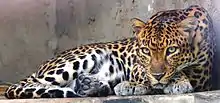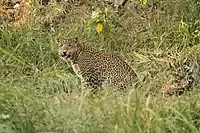Chinese leopard
The term Chinese leopard refers to any of the following three leopard (Panthera pardus) subspecies occurring in China:
- Amur leopard (P. p. orientalis) in Jilin Province of northern China, where it has been recorded by camera-traps in Hunchun National Nature Reserve.[1][2] Leopards cross between China, Russia and North Korea across the Tumen River despite a high and long wire fence marking the international boundary.[3]
- Indochinese leopard (P. p. delacouri) in Yunnan Province of southern China, where the Pearl River is thought to form a barrier to leopard populations farther north.[4]
- Indian leopard (P. p. fusca) in southern Tibet, where leopards have been recorded in Qomolangma National Nature Preserve.[5]



Taxonomic history
Several leopard zoological specimens from South and East Asia were described between the late 18th and early 20th centuries:
- Felis fusca was the scientific name used by Friedrich Albrecht Anton Meyer in 1794 who described a black leopard from India. This type specimen was on display at the Tower of London.[6]
- Felis orientalis proposed by Hermann Schlegel in 1857 was a leopard skin from Korea.[7]
- Leopardus japonensis proposed by John Edward Gray in 1862 was a leopard skin received by the British Museum.[8]
- Leopardus chinensis described by Gray in 1867 was a leopard skin from the environs of Peking.[9]
- Felis pardus sinensis described by Emil Brass in 1911 was a leopard skin from southern China.[10] Fossil leopard teeth excavated in southern China dating to the Middle Pleistocene were assessed as similar to those of P. p. sinensis.[11]
- Panthera pardus delacouri by Reginald Innes Pocock in 1930 was a leopard skin from Annam.[12]
Leopards in southern China were subsumed to P. p. delacouri following phylogeographic analysis in 1996.[4] In 2001, results of a genetic analysis indicated that P. p. delacouri and P. p. japonensis are contiguous, and that the latter is contiguous with P. p. orientalis.[13]
Chinese authors used P. p. fusca as a synonym for P. p. delacouri.[14] In 2017, the Cat Classification Taskforce of the Cat Specialist Group subsumed P. p. japonensis to P. p. orientalis, thereby recognising leopards in northern China as belonging to P. p. orientalis, while accepting the possibility of leopards in southern China as belonging to P. p. delacouri.[15]
Distribution
Camera-trap surveys conducted between 2002 and 2009 in 11 nature reserves in southern China recorded leopards only in Changqing National Nature Reserve in the Qinling Mountains, but neither in Sichuan's Wolong Nature Reserve nor in other protected areas in Sichuan.[16] Contemporary records of leopards exist from protected areas in the provinces Hebei, Henan and Shanxi and Ningxia. No leopard was recorded during surveys in Gansu province. Whether leopards still occur in Qinghai province is uncertain. It has probably been extirpated in Hunan, Hubei, Zhejiang, Fujian, Guangxi and Jiangxi provinces. It is listed as nationally Critically Endangered, but receives little attention from Chinese wildlife biologists and conservationists.[5]
Ecology
Contemporary ecological data on habitat use and requirements of leopards in China does not exist.[5]
Results of surveys in Wolong Nature Reserve in the 1980s indicate that leopards might have attacked giant pandas.[17]
Attacks on humans have also been reported, though they are rare.[18]
See also
- Leopard subspecies: Arabian leopard · Anatolian leopard · Persian leopard · Javan leopard · Sri Lankan leopard · African leopard · Panthera pardus spelaea
- Other wild cats in China: Chinese mountain cat · Asiatic wildcat · Asiatic golden cat · Leopard cat · Clouded leopard · Snow leopard · South China tiger
References
- Xiao, W.; Feng, L.; Zhao, X.; Yang, H.; Dou, H.; Cheng, Y.; Mou, P.; Wang, T.; Ge, J. (2014). "Distribution and abundance of Amur tiger, Amur leopard and their ungulate prey in Hunchun National Nature Reserve, Jilin". Biodiversity Science. 22 (6): 717–724. doi:10.3724/SP.J.1003.2014.14184.
- Yang, H.; Zhao, X.; Han, B.; Wang, T.; Mou, P.; Ge, J.; Feng, L. (2018). "Spatiotemporal patterns of Amur leopards in northeast China: Influence of tigers, prey, and humans". Mammalian Biology. 92: 120–128. doi:10.1016/j.mambio.2018.03.009.
- Nam, S. (2005). "Ecosystem Governance in a Cross-border Area: Building a Tuman River Transboundary Biosphere Reserve" (PDF). China Environment Series. 7: 83–88. Archived from the original (PDF) on 2015-10-03. Retrieved 2018-09-06.
- Miththapala, S.; Seidensticker, J.; O’Brien, S. J. (1996). "Phylogeographic subspecies recognition in leopards (Panthera pardus): molecular genetic variation". Conservation Biology. 10 (4): 1115–1132. doi:10.1046/j.1523-1739.1996.10041115.x.
- Laguardia, A.; Kamler, J. F.; Li, S.; Zhang, C.; Zhou, Z.; Shi, K. (2017). "The current distribution and status of leopards Panthera pardus in China". Oryx. 51 (1): 153−159. doi:10.1017/S0030605315000988.
- Meyer, F. A. A. (1794). "Über de la Metheries schwarzen Panther". Zoologische Annalen. Erster Band. Weimar: Im Verlage des Industrie-Comptoirs. pp. 394–396.
- Schlegel, H. (1857). "Felis orientalis". Handleiding Tot de Beoefening der Dierkunde, Ie Deel. Breda: Boekdrukkerij van Nys. p. 23.
- Gray, J. E. (1862). "Description of some new species of Mammalia". Proceedings of the Royal Zoological Society of London. 30: 261−263, plate XXXIII. doi:10.1111/j.1469-7998.1862.tb06524.x.
- Gray, J. E. (1867). "Notes on the skulls of the cats (Felidae)". Proceedings of the Zoological Society of London: 258−277.
- Brass, E. (1911). "Panther und Leoparden". Aus dem Reiche der Pelze. Berlin: Verlag der Neuen Pelzwaren-Zeitung. pp. 401–406.
- Hemmer, H. (1976). "Fossil History of Living Felidae". Carnivore. II: 58–61.
- Pocock, R. I. (1930). "The Panthers and Ounces of Asia". Journal of the Bombay Natural History Society. 34 (2): 307–336.
- Uphyrkina, O.; Johnson, E. W.; Quigley, H.; Miquelle, D.; Marker, L.; Bush, M.; O'Brien, S. J. (2001). "Phylogenetics, genome diversity and origin of modern leopard, Panthera pardus" (PDF). Molecular Ecology. 10 (11): 2617–2633. doi:10.1046/j.0962-1083.2001.01350.x. PMID 11883877.
- Smith, A.T. & Xie, Y. (2008). A Guide to the Mammals of China. Princeton University Press, New Jersey, USA.
- Kitchener, A. C.; Breitenmoser-Würsten, C.; Eizirik, E.; Gentry, A.; Werdelin, L.; Wilting, A.; Yamaguchi, N.; Abramov, A. V.; Christiansen, P.; Driscoll, C.; Duckworth, J. W.; Johnson, W.; Luo, S.-J.; Meijaard, E.; O’Donoghue, P.; Sanderson, J.; Seymour, K.; Bruford, M.; Groves, C.; Hoffmann, M.; Nowell, K.; Timmons, Z.; Tobe, S. (2017). "A revised taxonomy of the Felidae: The final report of the Cat Classification Task Force of the IUCN Cat Specialist Group" (PDF). Cat News (Special Issue 11). ISSN 1027-2992.
- Li, S.; Wang, D.; Lu, Z.; Mc Shea, W. J. (2010). "Cats living with pandas: The status of wild felids within giant panda range, China". Cat News. 52: 20–23.
- Schaller, G. B.; Jinchu, H.; Wenshi, P.; Jing, Z. (1985). The giant pandas of Wolong. Chicago and London: University of Chicago Press.
- Heptner, V. G.; Sludskii, A. A. (1992) [1972]. "Bars (Leopard)". Mlekopitajuščie Sovetskogo Soiuza. Moskva: Vysšaia Škola [Mammals of the Soviet Union, Volume II, Part 2]. Washington DC: Smithsonian Institution and the National Science Foundation. pp. 269–271. ISBN 978-90-04-08876-4.